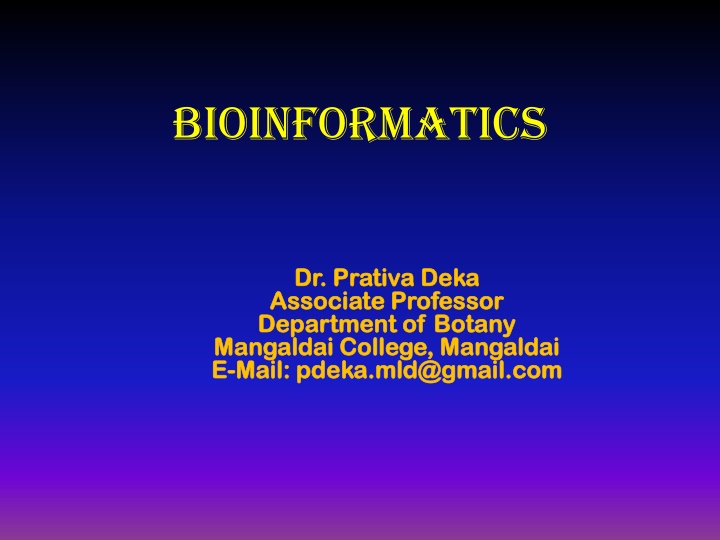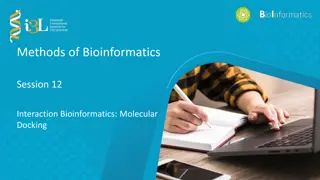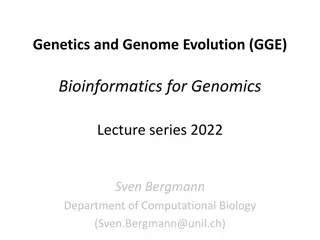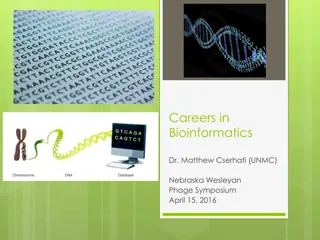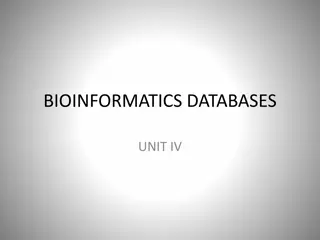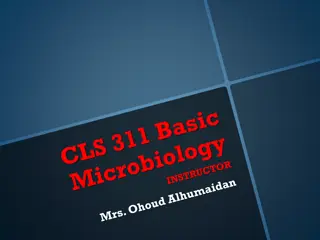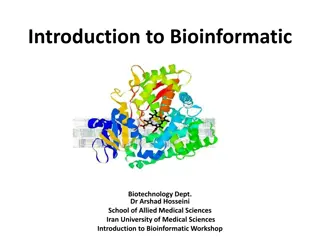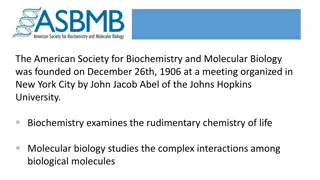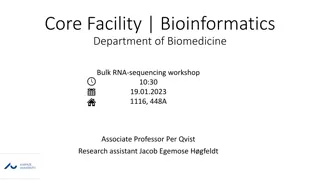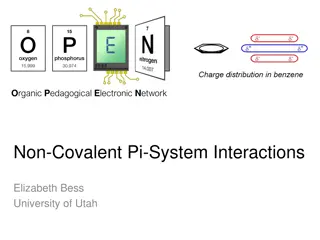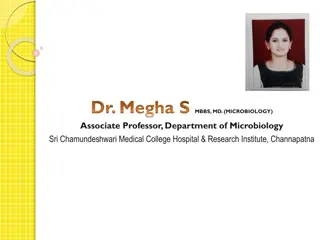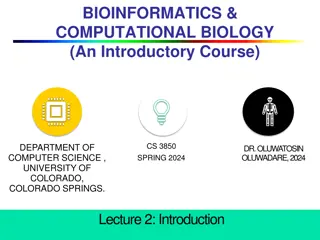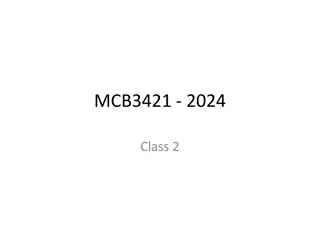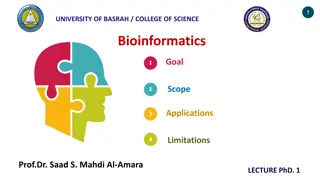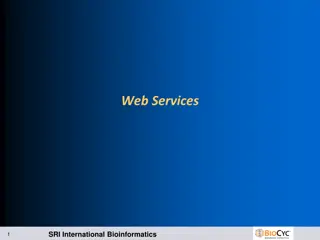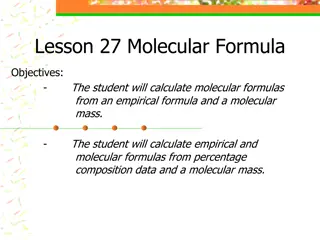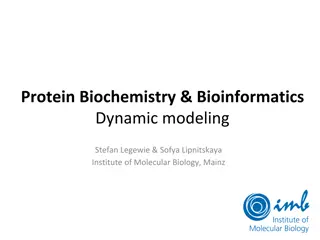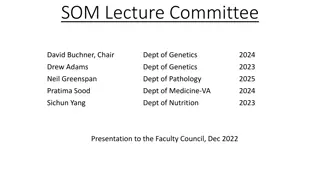Molecular Microbiology and Bioinformatics Studies
Molecular Microbiology delves into the study of microorganisms at a molecular level, focusing on physiological processes, macromolecules, DNA manipulation, and more. Explore the syllabus, lab activities, and examples in this field. Bioinformatics introduces basic molecular biology concepts, sequence analysis, phylogenetic studies, protein families, and post-genome analysis through database searching and tools. Dive into the world of molecular microbiology and bioinformatics with comprehensive content on these intriguing subjects.
Download Presentation

Please find below an Image/Link to download the presentation.
The content on the website is provided AS IS for your information and personal use only. It may not be sold, licensed, or shared on other websites without obtaining consent from the author.If you encounter any issues during the download, it is possible that the publisher has removed the file from their server.
You are allowed to download the files provided on this website for personal or commercial use, subject to the condition that they are used lawfully. All files are the property of their respective owners.
The content on the website is provided AS IS for your information and personal use only. It may not be sold, licensed, or shared on other websites without obtaining consent from the author.
E N D
Presentation Transcript
Bioinformatics Dr. Dr. Prativa Prativa Deka Associate Professor Associate Professor Department of Botany Department of Botany Mangaldai College, Mangaldai Mangaldai College, Mangaldai E E- -Mail: pdeka.mld@gmail.com Mail: pdeka.mld@gmail.com Deka
Bioinformatics: The field of science in which biology, computer science and information technology merge into a single discipline Biologists Collect Molecular Data: DNA & Protein Sequences, Gene Expression, etc. Bioinformaticians Study of Biological Questions by Analyzing Molecular Data Computer scientists (+Mathematicians, Statisticians, etc.) Develop Tools, Softwares, Algorithms to Store and Analyze the Data. Paulien hogeweg
From DNA to Genome Sanger sequences insulin protein Watson and Crick DNA model 1955 Dayhoff s Atlas 1960 Sequence alignment 1965 ARPANET (early Internet) 1970 PDB (Protein Data Bank) Sanger dideoxy DNA sequencing 1975 1980 PCR (Polymerase Chain Reaction) GenBank database 1985 3
SWISS-PROT database NCBI Human Genome Initiative FASTA 1990 BLAST EBI 1995 First bacterial genome World Wide Web Yeast genome First human genome draft 2000 4
Biological Databases Biological Databases What is a database? A collection of related data elements tables columns (fields) rows (records) Records retrieved using a query language Database technology is well established 2/28/2025 5
Tables (entitites) basic elements of information to track, e.g., gene, organism, sequence, citation Columns (fields) attributes of tables, e.g. for citation table, title, journal, volume, author Rows (records) actual data whereas fields describe what data is stored, the rows of a table are where the actual data is stored 2/28/2025 6
How online database work? When you query an online database, your query is translated into SQL, the database is interrogated, and the answer displayed on your web browser. Your computer and browser (the client ) Software to receive and translate the instructions you enter into your browser (on the server ) The database itself 2/28/2025 7 Image source: David Lane and Hugh E. Williams. Web Database Applications with PHP & MySQL. O Reilly (2002).
Why biological databases? Make biological data available to scientists Consolidation of data (gather data from different sources) Provide access to large dataset that cannot be published explicitly (genome, proteome, ) Make biological data available in computer-readable format Make data accessible for automated analysis Bioinformatics: To extract, store and to analysis the biological data
Biological Databases Over 1000 biological databases Vary in size, quality, coverage, level of interest Many of the major ones covered in the annual Database Issue of Nucleic Acids Research What makes a good database? comprehensiveness accuracy is up-to-date good interface batch search/download API (web services, DAS, etc.) 2/28/2025 9
Flow of Databases in Bioinformatics Biological experiments Computational Biology Biological Databases
Plants Genomes Databases Plant Genomes Databases
Ten Important Bioinformatics Databases GenBank www.ncbi.nlm.nih.gov nucleotide sequences Ensembl www.ensembl.org human/mouse/Plants genome PubMed www.ncbi.nlm.nih.gov literature references NR www.ncbi.nlm.nih.gov protein sequences SWISS-PROTwww.expasy.ch protein sequences InterPro www.ebi.ac.uk protein domains OMIM www.ncbi.nlm.nih.gov genetic diseases Enzymes www.chem.qmul.ac.uk enzymes PDB www.rcsb.org/pdb/ protein structures KEGG www.genome.ad.jp metabolic pathways In 1965, Dayhoff gathered all the available sequence data to create the first bioinformatics database (Atlas of Protein Sequence and Structure).
NCBI (National Center for Biotechnology Information) over 30 databases including GenBank, PubMed, OMIM, and GEO Access all NCBI resources via Entrez (www.ncbi.nlm.nih.gov/Entr ez/)
BLAST For Sequence Alignment Basic Local Alignment Search Tool Altschul et al. 1990,1994,1997 A best method for local alignment Designed specifically for database searches Benefits-Speed, User friendly, Statistical rigor, More sensitive Types of BLAST- BLASTN, BLASTP, BLASTX, TBLASTN, TBLASTX
THANK YOU THANK YOU
